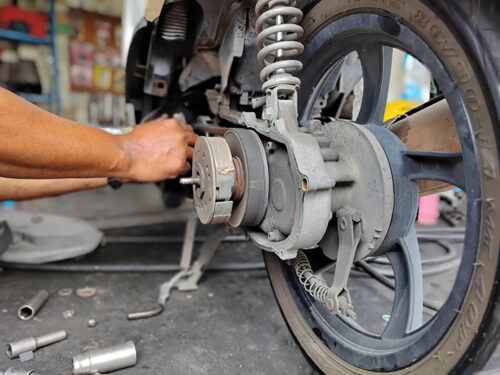San Leandro, CA – Common Brake Repair Problems Explained | Auto Repair Shop News
Posted in: Industry News
 As your trusted auto shop, keeping you safely and confidently on the road is our top priority at Precision Auto Care. And when it comes to safety, there’s nothing more essential than reliable, responsive brakes.
As your trusted auto shop, keeping you safely and confidently on the road is our top priority at Precision Auto Care. And when it comes to safety, there’s nothing more essential than reliable, responsive brakes.
Over our nearly 40 years serving the San Francisco Peninsula, we’ve seen just about every brake issue there is. We want to demystify some of the most common problems we repair, so you know what to watch out for between visits. Here’s an overview of the top seven brake issues we regularly address to keep our neighbors rolling smoothly.
Worn Brake Pads and Shoes
As the friction material on brake pads and shoes wears down with use, they begin losing their ability to grip. We see lots of vehicles come through with pads or shoes that have worn dangerously thin. How do our ASE-certified technicians tackle this? We thoroughly measure remaining thickness and replace pads or shoes that dip below manufacturer specifications. Allowing them to wear too far risks brake failure.
Warped Rotors and Drums
The high heat brakes generate can cause rotor and drum distortion or “warping.” This leads to annoying vibrations under braking. Our techs carefully gauge rotor and drum thickness and deviation from perfectly flat. Resurfacing them removes some material to restore flatness—but only if enough thickness remains. In advanced cases, replacement is required.
Sticking or Seized Calipers
Brake calipers house the pads and use hydraulic pressure to initiate contact with the rotors. Sticking or seized calipers cause uneven braking, pulling, and other issues. We’ll thoroughly inspect caliper operation, joints, bushings and pistons—cleaning or lubricating as needed. Full replacement is sometimes necessary.
Brake Fluid Leaks
A leak anywhere in the hydraulic brake system will eventually lead to failure. We’ll perform a brake inspection to check master cylinder, calipers, brake lines and hoses. Any identified leaks cause replacement of the faulty component. Leaking fluid also compromises performance, so we flush the old fluid and refill with fresh.
Corroded or Damaged Brake Lines
Rubber brake hoses and steel lines have a long but not infinite lifespan. We inspect your brake lines during repair or maintenance work. Corroded steel lines or cracked rubber hoses get replaced right away—you can’t afford to wait on essential brake components.
Air in the Brake Lines
Sometimes air gets into the hydraulic system, causing spongy pedal feel and poor braking. We perform a thorough brake bleed, working from the furthest calipers back to the master cylinder. This removes air pocket accumulation for solid pedal feel. Then we refresh the fluid.
Master Cylinder Failures
The master cylinder is the pump sending pressurized fluid through the system to engage your brakes. Failures here mean complete loss of braking power—so we test operation thoroughly. Rebuilding kits can sometimes get it working again, but we replace master cylinders at any sign of internal compromise.
As you can see, there are a number of ways brakes can begin to fail. But our ASE-certified technicians have the factory training, tools, and experience to set things right again quickly. Remember—we back all brake work with our satisfaction guarantee. Reach out to schedule your next brake inspection or repair.
Return to: San Leandro, CA – Common Brake Repair Problems Explained | Auto Repair Shop News
Social Web